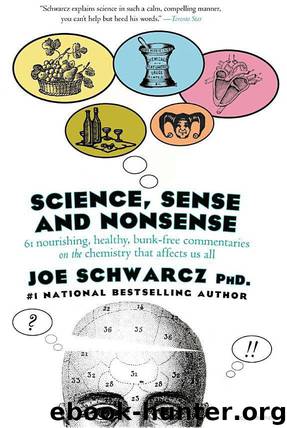Science, Sense and Nonsense: 61 Nourishing, Healthy, Bunk-Free Commentaries on the Chemistry That Affects Us All by Joe Schwarcz

Author:Joe Schwarcz
Language: eng
Format: mobi, epub
Tags: Science, Essays, Chemistry, Popular Works, General
ISBN: 9780385666046
Publisher: Random House Digital, Inc.
Published: 2009-11-03T00:00:00+00:00
PLACEBO IN THE GRASS
IT MUST HAVE BEEN quite a sight at the World’s Columbian Exposition in Chicago in 1893. Clark Stanley, better known as the Rattlesnake King, reached into a sack, plucked out a snake, slit it open and plunged it into boiling water. When the fat rose to the top, he skimmed it off and used it on the spot to create Stanley’s Snake Oil, a liniment that was immediately snapped up by the throng that had gathered to watch the spectacle. Little wonder. After all, Stanley had proclaimed that the liniment would cure rheumatism, neuralgia, sciatica, lumbago, sore throat, frostbite and even toothache.
It wasn’t too hard to convince the onlookers about the wonders of the liniment, particularly when it came to arthritis. All Stanley had to do was point out that snakes obviously did not suffer from this condition and seemed well lubricated internally. The crowd lapped up the hype and shelled out the money. And many claimed immediate relief from their pain. Could there have been something to this remedy? Maybe. But if it offered any relief, it wasn’t because of rattlesnake oil. It seems the snake act was only for show, and the liniment that was actually sold had been previously prepared. And not from snakes. Chemical analysis of a surviving sample revealed a mixture of mineral oil, beef fat, turpentine, camphor and red pepper. As it turns out, both camphor and capsaicin, the latter found in red pepper, do have some painkilling effect when rubbed on aching joints. But the most effective ingredient in Stanley’s snake oil was a good dose of placebo.
Actually, Clark Stanley didn’t come up with the idea of snake oil as a remedy. That notion can be credited to the ancient Chinese, who rubbed the oil on aching joints and claimed relief. Stanley probably heard about the remedy from Chinese immigrants who had come to America to seek their fortune. Many found jobs building the transcontinental railroad, and could well have used snake oil they had brought along to help deal with the backbreaking work.
Chinese snake oil, though, was certainly not made from rattlesnakes. Traditionally, the oil was extracted from the fat sack of the Erabu sea snake. And that makes things interesting. As it turns out, sea snakes, like fish, are rich in omega-3 fats. Being coldblooded animals, they have to be equipped with fats that don’t harden in cold water, and omega-3 fats fit the bill. Erabu sea snakes are even richer in omega-3 fats than salmon, a popular source of these fats. We’ve heard a great deal about omega-3 fats in recent years, including their potential benefits in improving brain function, reducing the risk of heart attacks, alleviating depression and even in helping with arthritis.
Ah, the arthritis. There really may be a connection here. Omega-3 fats are the body’s precursors to certain prostaglandins that are known to have anti-inflammatory effects. So Chinese snake oil might actually have a beneficial effect. If you ingest it! But rattlesnake oil contains
Download
Science, Sense and Nonsense: 61 Nourishing, Healthy, Bunk-Free Commentaries on the Chemistry That Affects Us All by Joe Schwarcz.epub
This site does not store any files on its server. We only index and link to content provided by other sites. Please contact the content providers to delete copyright contents if any and email us, we'll remove relevant links or contents immediately.
Alchemy and Alchemists by C. J. S. Thompson(2911)
The Elements by Theodore Gray(2432)
The Club by A.L. Brooks(2359)
How to Make Your Own Soap by Sally Hornsey(2339)
Drugs Unlimited by Mike Power(2191)
Wheels of Life by Anodea Judith(1608)
Cracking the Sat French Subject Test, 2013-2014 Edition by The Princeton Review(1520)
The Cosmic Machine: The Science That Runs Our Universe and the Story Behind It by Scott Bembenek(1479)
Perfume by Jean-Claude Ellena(1470)
The Flavor Matrix by James Briscione(1363)
1000 Multiple-Choice Questions in Organic Chemistry by Organic Chemistry Academy(1351)
Cracking the LSAT, 2012 Edition by Princeton Review(1344)
MCAT Physics and Math Review by Princeton Review(1304)
Cracking the SAT Premium Edition with 6 Practice Tests, 2017 by Princeton Review(1252)
Synchrotron Light Sources and Free-Electron Lasers by Eberhard J. Jaeschke Shaukat Khan Jochen R. Schneider & Jerome B. Hastings(1236)
Handbook of Modern Sensors by Jacob Fraden(1225)
A is for Arsenic: The Poisons of Agatha Christie (Bloomsbury Sigma) by Kathryn Harkup(1213)
Harry Potter All Books: 8 Books by J.k.rowling(1188)
Cracking the AP English Language & Composition Exam, 2018 Edition by Princeton Review(1032)
